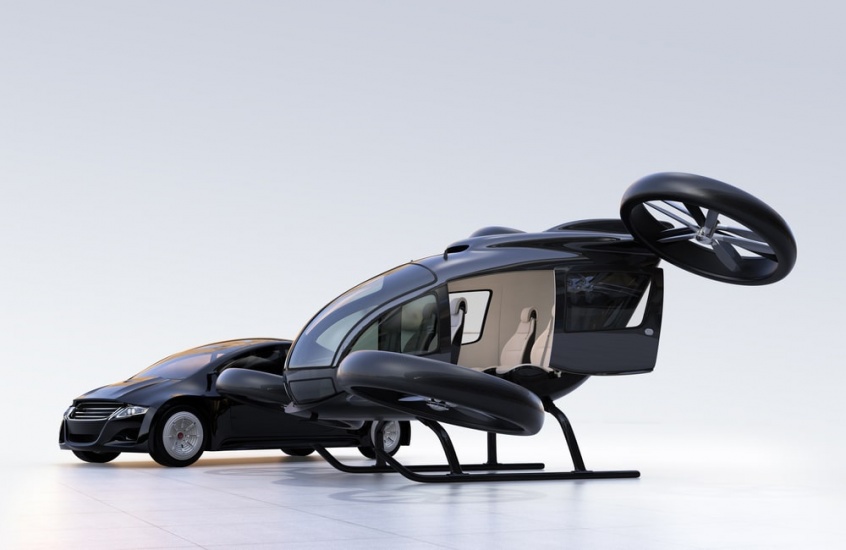If you’re interested in the benefits of VTOL technology for intra and inter-urban transportation, and the dream of the “flying car” is near and dear to your heart, you’re in the right place.
In this blog, we’ll look at the history of personal VTOL technology, and how the modern advancements in material design, engineering, and energy storage can enable the future of VTOL transport.
From the earliest helicopters to the latest advances in electric flight, we’ll be looking at the entire history of personal VTOL technology. Keep reading, and learn more about the history – and the future – of personal VTL transportation.
The First Unmanned Helicopter – 1877, Enrico Forlani
Helicopters remain the earliest form of personal VTOL technology. It was not until the 1960s that turbine-powered aircraft, such as the Harrier Jump Jet, were able to use thrust or power vectoring and jump jets to achieve VTOL.
Technically, the history of the helicopter can be traced back to China and Japan, where children played with decorated bamboo flying toys, called taketombo. In addition, Leonardo Da Vinci was one of the first people to seriously consider the idea of a helicopter, creating a design termed the “aerial screw”. However, he only made small models, and did not ever seriously explore vertical flight.
The first person to do so was an Italian inventor named Enrico Forlanini. In 1877, he built a steam-powered, unmanned helicopter as a proof-of-concept. The helicopter achieved the first known flight by a powered helicopter, as it rose straight into the air to a height of 13 meters, in a park in Milan.
The helicopter remained in the air for about 20 seconds, after which time it crashed to the ground. While it may not have been a perfect success, this test laid the groundwork for rotary aircraft as we know them today.
The First Manned, Untethered VTOL Flying Machine – 1907, Paul Cornu
Numerous individuals experimented with helicopters in the 1900s, including Thomas Edison, and two French brothers, Jacques and Louis Breguet.
Jacque and Louis managed to achieve the first manned flight of a helicopter, but their “Gyroplane No. 1” was completely unsteady. It lifted the pilot up to two feet in the air for about a minute, but had to be held in place by a man at each corner of the airframe, to avoid a crash.
Because of this, Paul Cornu, a fellow French inventor, claimed the title for the world’s first VTOL, untethered flight. His “Cornu Helicopter” lifted him into the air, untethered, at a height of one foot, for 20 seconds.
In subsequent flights, he achieved heights of over 6 feet, but his flying machine proved to be unreliable and unstable, and the project was abandoned.
Helicopters Become Widespread – 1920s-1940s
Much research was done on helicopters in the 1920s, 30s, and 40s, and inventors worldwide experimented with these personal aircraft, often with disastrous and lethal results.
The Autogyro was also invented at this time by Juan de la Cierva. This was an aircraft with an unpowered top rotor and a front propeller. The rotor provided lift by freely rotating when the vehicle was in flight. It proved to be much more stable than helicopters, but it was not a true VTOL aircraft, as it required either forward movement or an incredibly high wind speed to move its top, unpowered rotor and achieve lift.
Helicopters did not truly become widespread until the late 1930s, when the German Focke-Wulf Fw 61 was built. In the 1940s, Russian-born inventor Igor Sikorsky helped design the R-4, the world’s first production helicopter, after inventing the prototype VS-300 helicopter in the late 1930s.
Then, in the 1950s, the turbine engine became commonplace, leading to the development of helicopters as we know them today – and the groundwork used by most modern VTOL aircraft.
The Beginning Of Personal VTOL And The “Flying Car” – 1950s-1980s
As the post-war boom of the late 1940s and 1950s began, many individuals began turning their attention to “flying cars”, which can be thought of as the predecessors of the modern personal VTOL aircraft.
Henry Ford in the 1940s, famously predicted that flying cars were certain to become widespread in the near future.
The first such aircraft was the Aerocar, built and designed by Molt Taylor. Several successful road and air tests made it an initial success, and it was approved by the Civil Aviation Authority, but it did not make it into mass production.
The Ford Motor Company also experimented with personal aircraft, creating the Volante Tri-Athodyne, which was a 3/8 scale concept car model, which used three ducted fans to move the car through the air, and enable VTOL. The project was soon abandoned.
One of the biggest innovations took place in 1956, when the US Army began investigating “flying jeeps” which would be smaller and easier to fly than helicopters.
Manufacturers Chrysler, Curtiss-Wright, and Piasecki all delivered prototypes, and Piasecki’s VZ-8 was the most capable of the three, and could operate close to the ground, or up to several thousand feet.
However, research was abandoned after the army deemed the Flying Jeep concept to be “unsuitable for the modern battlefield”. Piasecki attempted to develop a modified version of the VZ-8 for civilians, but was unsuccessful.
Another Army research project was the Hiller VZ-1 Pawnee, a direct-lift rotor aircraft designed for a single pilot. It had a maximum speed of 16 mph and a service ceiling of 32.8 feet, and was operated by the pilot shifting his or her body weight for directional control.
Still another early project from the army was the Bell Rocket Belt, a single-person “jet pack” developed in the mid-1950s. It was demonstrated in 1961, but cancelled shortly thereafter, due to short flying times and low fuel capacity. However, it was briefly re-launched as the RB2000 Rocket Belt in the 1990s, and successfully flown for 30 seconds.
This was followed up by the Jet Flying Belt, which used a Williams International WR-19 engine, produced 430 lbs of thrust, and was first flown in 1969. Theoretically it, could fly for up to 25 minutes, and reach 84 mph. Again, though, it was deemed to be too sophisticated, dangerous, and inefficient for use by the Army, and never reached widespread production.
Modern Developments – From The Skycommuter To Modern VTOL Aircraft
By the 1980s, modern aviation designs had made “flying cars” much more practical. A former Boeing engineer named Fred Barker founded Flight Innovations Inc, which created the Sky Commuter – one of the first examples of a VTOL-powered, personal aircraft powered by duct fans. It was made of composites, and it was nearly 14 feet long. Unfortunately, it never made it to mass manufacture.
In the 1980s, the Williams X-Jet was released. Also called the “Flying Pulpit” due to its design, it was built for VTOL operation, and used a turbofan to travel at speeds of up to 60 mph for up to 25 minutes. It was eventually abandoned when the Army decided not to pursue further development.
Innovations in personal VTOL continued throughout the 1990s. The Moller M400 Skycraft is the next notable personal VTOL aircraft, invented by Paul Moller, who had been working on VTOL flight for more than 50 years. It was first tested in 2003, demonstrating tethered hovering capabilities. Unfortunately, the company is now defunct, and the M400 is on hiatus.
In 2006, Urban Aeronautics announced the X-Hawk, a VTOL turbojet aircraft that would be about the size of a small van, and be practical for both driving and flight. It has been tested successfully, but is not yet available for widespread purchase.
In the early 2000s, another company, Macro Industries, introduced the SkyRider, a VTOL-powered personal aircraft with a length of 14 feet, range of up to 920 miles, and a cruise speed of 288mph. However, by 2005 no workable prototype had been built, and the project is now widely thought to be defunct.
Terrafugia, a (now) Chinese startup, has also announced a VTOL aircraft known as the Transition, which was first flown in 2009, and has a flight range of 489 miles, VTOL capabilities, and can drive up to 70 mph in normal traffic. By 2014, multiple two-person test flights had been successfully achieved, and the Transition is expected to enter Russian markets by late 2018, and Uber is planning to use the Transition by 2023 in Los Angeles.
In 2013, aerospace engineer Michel Aguilar revealed the Xplorair, a personal aircraft powered by four Wankel rotary engines, built without a rotating airfoil. It also lacks wheels, making it a true VTOL aircraft which is not intended to be driven on roads. A full-scale drone flight in 2017 was successful, and the first manned prototype is scheduled to be built by 2020, with widespread release by the early 2030s.
Another notable personal VTOL aircraft is the PAL-V, an autogyro which has a three-wheeled, roadable design. Introduced in 2012, it entered mass manufacture in May 2014, with each unit costing 500,000 euro.
The Future – Current Prototypes And Projects
Beyond these above “flying cars” and personal VTOL aircraft, there are many other startups working on creating the VTOL aircraft of the future.
Some of these startups include E-Volo and the Volcopter. This single-passenger aircraft made its first flight in 2016, and is expected to enter production in just two years.
The Ehang 184 is also a notable VTOL aircraft, built for autonomous operation with eight propellers, a one-passenger design, and a maximum cruising speed of 100 mph.
Another promising project is the Opener BlackFly, the world’s first ultralight, electric, fixed-wing VTOL aircraft, with a range of 25 miles. First revealed in 2016, the team has been working on this prototype for more than 9 years.
Surefly by WorkHorse is a more traditional helicopter, but it’s designed for simple operation, with a gas-powered engine used as a generator, eight propellers, and full redundancy to make it easy to pilot.
The Jetpack Aviation Jetpack is another example of a promising design in the world of personal VTOL equipment. This jetpack was part of the first FAA-approved jetpack flight around the Statue of Liberty. The most recent, 6-engine pack can reach speeds of 120 mph, and includes safety features for auto-stabilization and emergency flight.
Finally, Lilium offers a, non open rotor based design, which uses electric ducted fans, a 300 km range, and a 300 km/h top speed. It’s been successfully tested.
The Future Of VTOL Is Brighter Than Ever!
As you can see from the history of VTOL – and the massive number of current and ongoing projects – there are dozens of companies dedicated to innovating, and solving the problems facing modern personal VTOL aircraft.
It’s only a matter of time before VTOL becomes affordable, widespread, and commonplace. Hopefully, this article has given you a good sense of the past, present, and future of VTOL technology – and you’re encouraged to keep following the progress of the “flying cars” of tomorrow!

